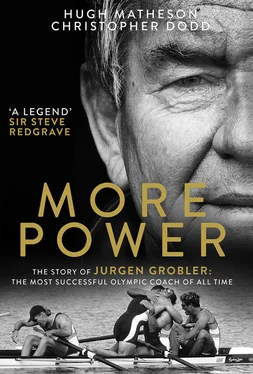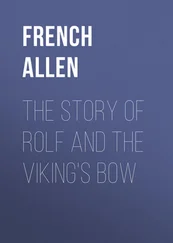However, doping played only a small part in Grobler’s application of the best science flowing from the German College of Physical Culture in Leipzig and elsewhere. The East German team used boats built beside the River Spree in Berlin using a hull profile that was unique at that time. It was designed to have the lowest wetted area – that is, the amount of skin in contact with the water – to reduce the friction or drag. It was designed to pitch and yaw less as the oarsmen moved their weight back and forth on the runners of their sliding seats. It had enough stiffness not to wallow as the weight within it shifted, but was flexible enough to absorb much of the counterforce of rough water to minimise slow-down.
Up to this point, individual boat yards had modified existing designs to seek incremental improvements. They had been subject to fashion but not much hydrological research. The East Germans went about it with legendary thoroughness and seemingly unlimited financial resources. The naval architect who bossed the programme from the start, Klaus Filter, had started rowing at sixteen in Berlin when he began an apprenticeship with the racing-boat builder, Friedrich Pirsch. As his rowing and sculling improved he was steered in the direction of the newly empowered College of Physical Culture in Leipzig ‘to fill his time while in training’. After graduation he went back to work at Pirsch. By the mid-Sixties he was obliged to look for new materials to build the fine shells because East Germany was finding it difficult to import the South American cedars which were then deemed the only material combining strength and flexibility in appropriate measures. The East German state aircraft manufacturer, EFW, had been put out of business in 1961 – probably as a result of Russian interference – and its facilities were made available to the burgeoning sports-equipment research programme.
Filter was able to start experiments with light and strong plastic ‘sandwich’ materials and in his thirties he decided to enhance his boat-building skills by taking a two-year naval architecture course at the university in Rostock. From that he began developing boat designs from first principles. Theoretically they were the fastest built, but they were impossible to row. The means to a solution for the ‘perfect design’ versus ‘practical for humans to row’ was ready-made because rowing as a national sport was already functioning in all its aspects through a committee of the leading coaches, training scientists, experts in biomechanics, medical men, with Filter heading up the technology side with boat designs and materials. Filter says Grobler was, from the beginning, an authoritative voice who understood that collaboration with the other key elements would bring the results the state required.
Biomechanical work with athletes, combined with Filter’s hull dynamics, was crucial in developing the style of rowing which obtained the best out of boats and men. East German crews rowed a long arc by curving the back forwards to enable the arms to reach a long way forward without unduly compressing the legs onto the foot-stretcher that is fixed to the hull. The boat is then levered past the point where the blades are locked into the water. The large flat area of the blade prevents it being torn through the water while the boat is drawn past the lock point by the strength and skill of the oarsman. This rowing style places more strain on the lower back muscles than could be borne by many western oarsmen who trained under a shorter but more intense regime. The East German coaches had full-time professional athletes and so could indulge themselves with long sessions at less intense pressure. They could develop the lower-back strength slowly and carefully over time. The bodies, the style and the boats were each designed for maximum compatibility. Filter, assisted by Grobler, was working to perfect the knowledge of the amount of flex and best hull shape for the boat to match the reaction time of the athletes. If the boat rolls, the rowers must adjust their weight and application of power to match. If the reaction is too slow the roll becomes worse and the boat speed is impaired. The task at which they excelled was to match training to boat shape so as to produce the style of propulsion desired to cover the endurance distance of 2000 metres. It was not a sprint: Grobler and Filter succeeded in developing a type of training that matched athletes and their boats to the distance.
In 1972 Güldenpfennig was given a boat with a plastic laminate hull, finished in soon-to-be-ubiquitous Wehrmacht grey, fitted with a wooden seat and washboards. It was the latest development. Götz Draeger, the man he replaced, had won silver in the European championships in Copenhagen in 1971 in a wooden shell, along with all his teammates. Film of the final in Munich shows Güldenpfennig sculling in the same style as the sweep oarsmen, using his curved back and outstretched arms at the start of the stroke to place the blades in the water as far forward as possible.
The ironies of East Germany’s dominance of Olympic rowing in Munich were many. The original award of the Games to the Bavarian capital by the International Olympic Committee had given immense satisfaction to its president, Avery Brundage. Brundage had risen from poverty on Chicago’s east side to own the largest construction group in the city and to forge a dominant role in US athletics. He had one obsession, which was a hatred of communism and communists, and one closeted dislike, which was for Jews. To hold the Games in a state that shared a long, walled-off border with a communist one must have pleased him.
Munich’s organising committee rose so high to meet the expectations of the Olympic family that hubris was almost certainly heading for a fall. From the start, the Soviet Union and East Germany were winning half as many golds again, with fewer athletes between them, than the United States and West Germany combined. Then on 5 September, early in the second week, came the devastating hostage-taking and murder of thirteen members of the Israeli team by Black September terrorists. The East German rowers were not there to see the shaming of the West German security services in their botched response to the crisis. They had been sent home immediately after their medal ceremonies to avoid western temptations in general and defection in particular.
Brundage, aged 85, who was due to retire as president of the IOC at the end of the Games, spoke at the hugely moving memorial service in the main stadium on the following day. He said that the ‘Games must go on’ and was applauded warmly. But some later revised their opinion after noting Brundage’s deemed hostility to Judaism had been particularly evident in his support for US participation in the Berlin Games of 1936.
The circumstances of Munich’s embarrassment left the East German leadership enjoying a moment of schadenfreude . Although beaten by two scullers, both of whom could be described as idiosyncratic and brilliant, Grobler’s protégé, Güldenpfennig, was a great example of a socialist team ethic. He had only himself to rely on in his races, but he was shaped in the classic East German mould, an interchangeable cog in a bigger machine. He would race the single again in 1973, with the same bronze-medal result, but thereafter he moved into the quadruple-sculls event, introduced to the programme at the 1974 world rowing championships and won by East Germans every year without interruption until 1993.
Jürgen Grobler was hitched to this star and accompanied him, as coach of the quadruple scull, to his first Olympic gold in Montreal in 1976.
Конец ознакомительного фрагмента.
Текст предоставлен ООО «ЛитРес».
Прочитайте эту книгу целиком, купив полную легальную версию на ЛитРес.
Читать дальше












